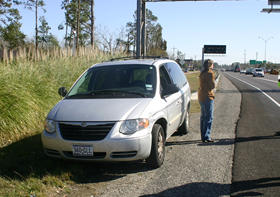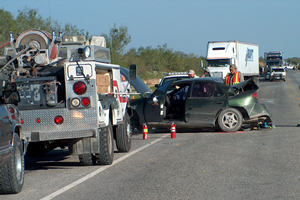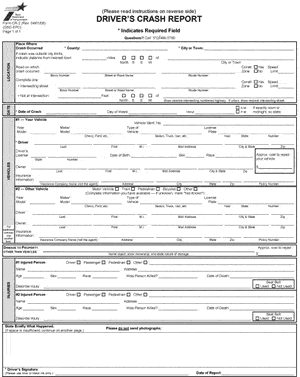According to the National Safety Council one in every eight drivers will be involved in a crash this year.
If yo u are involved in a collision, follow these steps:
u are involved in a collision, follow these steps:
- As long as it is safe and clear, you should move your vehicle out of the traveled portion of the roadway. This is the law on many freeways and divided highways. In some its against the law to move vehicles after a collision. Knowing the ordinances for your area is important.
Turn off the ignitions of the cars involved.
Make a first aid check of all persons involved in the crash.
Call the police and, if necessary, emergency medical services.
Mark the scene of the crash with retroreflective triangles.
Gather the names of all persons in the motor vehicles and people who witnessed the crash.
Make a quick diagram of where the vehicle occupants were seated and indicate the vehicles' direction of travel and lane. Also note the date, time and weather conditions.
Ask to see the other driver's license and write down the number.
Exchange insurance company information. Do not discuss "fault" or make statements about the crash to anyone but the police.
Get a copy of the police report of the crash from the local precinct.
When to Call Police
Always call the police when:
an injury or fatality is involved,
the vehicles cannot be moved,
you suspect one of the drivers is intoxicated,
one of the drivers has no insurance, or
one of the drivers leaves the scene.
When to Move Your Vehicle
If you are in a collision and no one is hurt, don't wait for the police before moving your vehicle. If you can drive the vehicle, the law requires you to move it out of the flow of traffic.
If there is damage to the vehicle, stop and exchange information. If someone is hurt, render aid and notify law enforcement. If you hit an unattended vehicle, find the driver or write your name and address on a note explaining what happened. You must also include the owner’s name and address if the vehicle you are driving doesn’t belong to you.
 When to File a Crash Report
When to File a Crash Report
If a law enforcement officer is not investigating the crash, you must file a crash report [Word, 2 pages, 308kb] with TxDOT within 10 days if:
there are injuries or a fatality,
you suspect property damage exceeds $1,000, or
you suspect a driver is intoxicated, unlicensed, has no insurance or attempts to leave the scene.
If you don’t file a report, you’re subject to up to a $500 fine, plus court costs.
You can download a copy of the crash report from the Texas Department of Transportation at http://www.dot.state.tx.us/services/traffic_operations/crash_reports.htm or go to one of their local offices.
Encountering a Traffic Accident

If you come across a traffic crash, don't just ignore it, if you aren't trained in first aid, you shouldn't try to be a doctor. You could do more harm then help. Instead, do the following:
Send for help! This is the most important thing you can do.
Try to help the injured where they lie. Keep them warm.
If they are bleeding, place a clean cloth over the wound and apply pressure with your hands to slow the bleeding. Be careful not to come into direct contact with blood.
Do not move the injured unless there is immediate life-threatening danger. Movement could cause more injury.
If the injured can walk, try getting them to sit or lie down on their back.
Don't try to take an injured person to the hospital yourself unless there is no way to get help. With serious injuries, improper movement may be harmful.
According to the Texas Department of Transportation, if you encounter a collision:
- Check for injuries. If people are hurt, tend to them.
- Move your car out of the roadway to a safer place where you can exchange names, addresses, phone numbers, vehicle identification numbers, vehicle license plate numbers, insurance information and driver license information.
- Note the location of the crash and get the names, addresses and phone numbers of any witnesses.
- If the vehicles cannot be moved, protect the scene by setting up flares or raising your hood.
What to do After a Collision Collision Class Comedy







 When to File a Crash Report
When to File a Crash Report







